#like pathfinder 2e!! rangers are so good there
Explore tagged Tumblr posts
Text
YOUR FAVS IN BG3: Link and Zelda from ToTK!
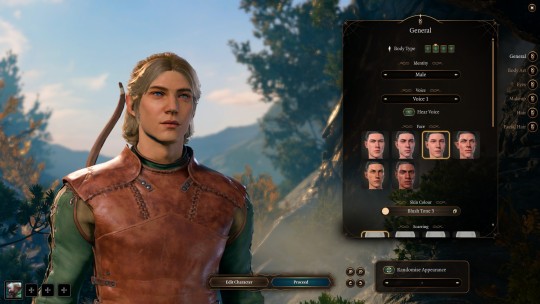

Link, the half-elf folk hero Ranger, and Zelda, the half-elf noble Wizard.
Reasoning and builds under the cut!
These are specifically from Tears of the Kingdom/Breath of the Wild because there is so much variety in the Links and Zeldas of the series as a whole! I've also only played BotW and ToTK so I'm most familiar with these incarnations. I do plan to attempt making other incarnations, but I'd want to get more familiar with those games first before jumping in. (I do know that OoT Zelda would be a monk, for obvious reasons, but beyond that I don't know much.)
Both Link and Zelda are half elves here because I feel that fits the Hylian aesthetic the best.
LINK
First up: why is Link a ranger and not a fighter? I decided on ranger because of their focus on wilderness survival. Plus, they've got the "ranger knight" subclass which implies service to a noble house; in my mind, that fits Link being the Champion of Hyrule and Zelda's chosen protector. Ranger's limited spellcasting ability is also a nice nod to the runes and abilities he's able to use in both Breath of the Wild and Tears of the Kingdom.
His background being "folk hero" feels kind of self explanatory; he's one of the most famous warriors in all of Hyrule, even if no one recognizes him when they first meet him.
Link is a wood half elf, for that movement speed buff. Boy's gotta zip around all day, he's gotta be quick about it.
Build
Despite him being a ranger from the start, the best class to describe Link would be the Eldritch Knight fighter subclass. However, having played that subclass, it can feel kind of underwhelming. I believe a Ranger/Fighter multiclass allows for a similar vibe while being more effective in combat.
For level one stats, he has 16 strength, 16 dexterity, 14 constitution, 8 intelligence, 10 wisdom, and 10 charisma (all pictured below).

I've chosen for wisdom to be kind of a dump stat because he's the Hero of Courage, not the Hero of Wisdom. Man's is a little bit stupid and that's okay. Also, in my experience, the most useful ranger spells are either passive buffs (like Hunter's Mark), or damaging spells that rely on your attack roll to hit (like Ensnaring Strike).
Once Link levels up, he'll be taking an immediate level in fighter. It's important to get second wind and action surge as soon as possible, just because of how useful they are in combat. Also, it's a good analog for flurry rushes and going absolutely ham with the apples to heal during combat.
Beyond level 2, there are a couple different paths that make a ranger/fighter build good. These are just what I've personally experimented with, so if you wanna do something else, go nuts!
One is to go three levels ranger and nine levels fighter. This lets you pick up the "Hunter" subclass and the Horde Breaker ability, which is very good. (Honestly all the Hunter's Prey options are great, it really depends on personal preference.) Fighter subclasses are between Battle Master and Champion; either are fantastic, but I've found Battle Master to be a little overwhelming. If you just want to whack stuff, go with Champion. If you're okay with strategy, Battle Master fits with the "lore" of BotW/ToTK Link better.
Another option is to just do one or two levels of ranger, and slam the rest into fighter. If you do a 1 Ranger/11 Fighter split, you get access to 3 attacks per turn, which is very very nice. A 2 Ranger/10 Fighter split is pretty much the same, but this time you get two spells. Whoopie! These builds definitely offer more raw damage, but I personally don't see the point in having this small of a split. It kind of makes Ranger redundant, so I personally wouldn't go this route. If you're hungering for extra attacks, Hyena ears let you make haste potions, but Wizards can cast it as soon as they get access to level 3 spell slots. (The Darkfire Shortbow also lets you cast it on yourself once per long rest. You got options if you wanna get extra attacks and actions!)
The inverse of this (10 Ranger/2 Fighter) gives you access to action surge, second wind, and you get access to much more spells and more interesting class abilities. This is my personal favorite combination, because I'm a filthy ranger defender. Even so, I can recognize it needs the little extra oomph fighter can offer.
ZELDA
Zelda was actually a lot harder to decide on a starting class for. She's definitely a spellcaster, and an argument can be made that she's a divine spellcaster and therefore should be a Knowledge domain cleric. (Also, her holding the Triforce of Wisdom? That's cleric shit if I've ever heard it.) I can also see an argument for her being a sorcerer, as her powers come from being a reincarnation of the Goddess Hylia.
If there was a divine soul sorcerer class in BG3, it'd be that, hands down. However, there's not, so I personally discount sorcerer as an option here. (Would love to see a Zelda build using this in pen and paper, though.)
(ToTK Spoilers in this paragraph) There's also a very convincing argument that it'd be most fitting to make her a dragon soul sorcerer, because gestures at ToTK. However, I don't think it fits beyond that, though the comparison makes me laugh. Figured I'd mention it for that reason alone.
I ended up with Wizard because most of her work, in both ToTk and BoTW, is scholarly in nature. Zelda is most driven by knowledge and her desire to do better by her people, as opposed to devotion to a god.
Build
Zelda's level one stats are 8 strength, 8 dexterity, 12 constitution, 16 intelligence, 16 wisdom, and 14 charisma (as pictured below). Her starting spells are Mage Armor, Shield, Protection from Good and Evil, Sleep, Magic Missile, and Feather Fall. Her cantrips are Mage Hand, Blade Ward, and Friends. As a high half elf, I gave her the Light cantrip as another nod to her divine power manifesting. (All in the picture below, but it might be hard to see.)
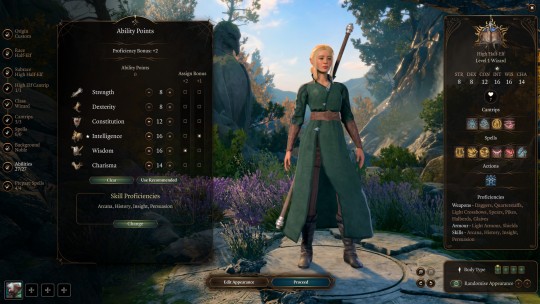
In terms of leveling up, I think an argument can be made that a cleric multiclass might not be a bad idea. However, builds like that are Multi Attribute Dependent (MAD), so they can be a bit difficult to level properly to feel effective. I've never personally experimented with it, and have been advised by friends who are better at this game to avoid MAD builds. I just think it'd be neat, which is why I mention it as an option.
Overall, Zelda has a pretty simple level up scheme: level up into Divination Wizard, get her hands on as many scrolls as possible, and keep learning spells till she drops. Wizards are a versatile and powerful class already, so while multiclassing is tempting, I personally avoid it here.
There is, however, a very very compelling argument for getting three levels in sorcerer, subclass of your choice. Using sorcerery points to get more spell slots, quickened spell and twinned spell... All extremely fun things to play around with. Plus, I love Wild Magic dearly. I don't think this multiclass fits Zelda very well, but it's such a good combo that I had to mention it.
#bg3#totk#link#zelda#totk spoilers#(i mean not really but just in case)#bg3 builds#bg3 character creator#bg3 tav#uuuh idk how to tag shit i just know i need to#also despite how much i love both of these games i have yet to beat either of them so keep spoilers to a minimum#thank you i love u all#also yes ranger is my favorite class but i never play it unless I'm playing something other than DnD 5e#like pathfinder 2e!! rangers are so good there
2 notes
·
View notes
Text
Daggerheart - What I've Seen So Far
Template-Based Character Builds
This will be familiar to players of D&D, Pathfinder 2e, Monster of the Week and similar systems where you choose from one of several existing classes, playbooks, ancestries, backgrounds, and the like.
The selection of templates here come in three categories:
Classes
Ancestries
Communities
Classes
Classes are built along lines familiar to D&D players with the following options.
Bard
Druid
Guardian
Ranger
Rogue
Seraph
Sorcerer
Warrior
Wizard
Most of these are what they appear to be, with Fighter and Barbarian bundled together across Guardian and Warrior, with one being more tanky and the other being more damage oriented. Cleric and Paladin are represented together by Seraph.
Each of these classes has subclasses similar to D&D with each currently having two options. These subclasses start with a "Foundation" ability, moving to "Specialization" and then "Mastery". I'm curious at this moment whether in the future each subclass will have multiple Specialization and Mastery options but currently there's only one to each subclass.
Each class also has two "Domains" which determine the selection of other skills they can draw from. This has similarities to both City of Mist's themebooks, with the exception that the Domains are hardlocked to each class, and Pathfinder's Class feats, with the exception that each class is going to overlap their abilities with other classes.
For example, Warrior and Ranger each have access to the "Bone" Domain abilities while Druid and Sorcerer all have the "Arcana" Domain.
Initially, a character will have two of these abilities but they will get more as they level up, with the ability to have at most five active at any given time, with a cost to switch abilities out if you suddenly decide you need X instead of Y.
This smacks a bit of Vancian casting, spell-slots and the like, however there are two closer mechanics, one of these also from Darrington Press. In Candela Obscura you have a list of items which you can declare you have at any point, but only up to three-items. Then there's Scion 2e, where you can buy as many Knacks as you want, but you can only have a number active equal to your ranks in associated Callings.
Ancestries and Communities
These represent the character's genetic heritage, what D&D currently refers to as Races. These have a basic ability like a Daemon's "Dread Visage" helping them to intimidate others. At current moment, there doesn't appear to be a list of future abilities connected to Ancestry similar to Pathfinder's Ancestry Feats.
Similarly, Communities are similar to Backgrounds in both D&D and Pathfinder and come with a similar power to those found in Ancestries. Again, there doesn't seem to be a sign of other powers based on Community as you level up. But this is no different from Pathfinder or D&D.
Analysis
It's familiar enough to D&D and Pathfinder that a lot of people are going to be comfortable with it. The use of cards feels a bit like a gimmick, but I imagine it will make parsing through abilities a bit easier for a lot of people since you can cut down to just your abilities rather than look through the entire book. Assuming more abilities get put out as the game moves on, this is essentially not too different from D&D/Pathfinder Feats or Scion Knacks.
From a design perspective it's also a good move since new classes will only require building the basic class features and subclass features and the majority of the abilities will come from the same pool.
All in all, it's easy for D&D players to pick up and appealing enough to those of us whose home games are more of the narrative variety.
Health and Defense System
The Health System is probably the most innovative part of this game.
First, the parts of the system that are elements I've seen before:
Separate Evasion and Resilience is a thing that has been around for ages. Champions/Hero System has done it since the early 80s and it also shows up in Storyteller, Storypath, Cypher system, Mutants and Masterminds, and so on.
The combination of Stress and Wounds is also something I've seen before. Notably in City of Mist and Fate.
Armor as a resource that gets expended also is something I've seen in The Fellowship, Scion 2e, and several other such things.
Capped damage... and this is initially the one that stood out to me as the that's cool... appears in Scion 2e where the most you can deal with any attack is 2 Wounds... in a game where one Wound is enough to take out most enemies.
Low Health totals are a common build design for PbtA games, Fate, Scion 2e, World of Darkness, City of Mist, and several other games.
It's the Damage Thresholds added in here that makes this most interesting thing and where it avoids the pitfalls that affect some of these other systems (note that Fate, MotW, Scion 2e, and City of Mist are the systems I consider my "home games" so yes, I'm pointing out their pitfalls.
The Damage Thresholds allow for the fun of rolling huge numbers and building significant differences between squishies and crunchies without making balance too difficult.
Capping the damage at 3 where all players have 6 HP at base means that you're never going to have a player be one-shot. It shares this feature with Scion 2e. Though Scion 2e has the options to spend extra success on other things beside damage, so allowing for a more scenery chewing, cinematic, superheroic style of fight (the developers of the game point to the fight between Kratos and The Stranger/Baldur at the start of God of War as what they wanted for Demigod tier combat).
However, the Damage Thresholds and rolling damage are likely to be more intuitive to players only familiar with D&D.
PbtA matches low Harm/HP counts with static damage: a knife will always deal 1 Harm, for example. Similar to Scion 2e, this prevents characters from being taken out in one blow ... you know, unless the static damage is something like 6 or 8... which feels like a bad choice on behalf of the GM. But not rolling damage can be a little jarring the first couple of times you encounter it.
Those are minor issues. Scion 2e, City of Mist, Monster of the Week, and Fate were all built in a world where the big risks were already apparent and demonstrated. The differences between them and Daggerheart is significant, but which you prefer is largely going to be a matter of preference.
Hero System and old Storyteller system is where the danger of separating evasion and resilience. Hero System tanks become incredibly difficult to damage even when you do hit them because their resistances cancel out all the damage. Building attacks to get around that tends to be expensive. Likewise, high Speed or Defense characters can be just impossible to even touch... though you can counter that with area effect attacks.
In a lot of Storyteller (World of Darkness, Scion 1e, etc) systems Dexterity got marked as a "God Stat" usable for both attack and defense and where their armor mechanics were far less reliable.
Daggerheart gets around both those major balance issues. It does have the potential for some psychological downside in that rolling especially high damage rolls may feel like you're wasting effect. However, it looks like part of how they do multiple attacks or area of effect is let you roll damage and split it up between multiple attacks as you desire. So if you did a massive amount of damage, you can apply the bulk of the effect on a main enemy and scatter the remaining damage to several of the minions around them.
As far as resisting goes... a Warrior is going to be a lot harder to damage once you hit them than a Rogue, but they will still have to deal with being slowly nickel and dimed down. High Evasion characters will avoid most attacks, without the risk being pasted by a single strike.
This reduces the scenario design burden on the GM since they don't have to worry as much about overwhelming the tanks or flattening the dodgers (or casters) in a single roll.
Death Move, not Taken Out
One side note is that Daggerheart does not use a Taken Out mechanic. When your HP go to 0 you have three options:
Go out in a blaze of glory.
Risk a scar and resist death, scars are more likely the higher level you get.
Risk it all and roll hoping your Hope die is higher than your Fear die at the risk of dying flat out.
This is in comparison to Scion 2e and Fate where getting Taken Out mostly just means that you are out of the scene and death is a matter of choice and negotiation between player and GM. This presents the players from being blindsided by death and getting drama out of defeat such as being captured or separated from the group. Or... they can let their character die if they feel it is narrative enough.
Daggerheart similarly has ways to avoid death blindsiding the group and derailing campaign progress with the need to introduce a new character and the loss of story arcs that had been built up. But death still remains a risk, similar to City of Mist or Monster of the Week. (Though Monster of the Week has a significantly dramatic resurrection mechanic.)
Action Resolution System
The d12+d12 system is a bit interesting. You roll 2d12, each a different color called "duality dice". One of the dice is Hope and one is Fear. If your Hope die is higher than the Fear die, then you gain a Hope (the meta-currency of the game), but if the Fear die is higher, the GM gains a Fear (the GM's version of Hope). If the two dice are equal, that's a critical success.
They list Genesys as a Touchstone, and I can see its DNA here. Genesys uses a number of signature dice and you roll large dice pools of positive dice versus large dice pools of negative dice generating and cancelling out resources. It was not nearly as bad as I expected it to be and, in fact, I found it quite a fun system to play, but it is intimidating to a newcomer. Heck, as implied, I was doubtful of it before I played it.
This is more similar to rolling Fate dice where you roll 4d6 where the sixes are each marked with 2 blank, 2 minus, and 2 plus sides. Add those together and you get a range of effect from -4 to +4. But again, they haven't listed Fate as a direct Touchstone, so I don't think this is deliberate. If it was Hope minus Fear the comparison would be almost exact.
As a note, this d12+d12 method creates a slightly higher chance of getting a critical hit. As seen here in an Anydice comparison, the chance for a critical hit on this method, where the dice roll the same number, has an 8.33% chance of success compared to a 5% chance with rolling a natural 20... and no chance for a critical failure.

The "with Hope" and "with Fear" also allows the GM to describe a success that yet promises coming danger (succeeding with fear) or a failure that yet gives a sign that all is not lost (failing with hope).
As a note, it appears that the GM rolls a d20 instead of d12 + d12. This means that they have a narrower and more swingy success rate compared to the far more consistent and reliable PCs. PCs are going to find their results cluster around a die roll of 13, making bonuses more impactful. This is a benefit of game systems that don't use a flat curve (single die).

The choice to make rolling pairs the critical hit result neatly avoids the downside of crisis resolution methods that avoid flat curves where critical hits are either very rare or else come about as a result of a player just spending tons of resources at once to turn a good roll into an amazing on as happens in Fate (granted, I love that a lot of the success and failure of Fate is hinged more on the player choice to spend resources than on random chance, but there is something to be said for the natural 20 moment).
Speaking of Fate and spending resources, this is the point where I point out that Daggerheart is a Fortune-at-the-End system. To explain this:
Fortune-at-the-End: Barring a few special abilities, the die roll is the last step of an action resolution. Spending resources comes before you roll. D&D is Fortune-at-the-End
Fortune-in-the-Middle: Rolling the die is a middle step and the player can choose to spend resources after the die is rolled. Fate is Fortune-in-the-Middle.
Fortune-at-the-Beginning: Rolling a die would come at the start of the action, generating resources which the player then spends to accomplish things. 7th Sea is Fortune-at-the-Beginning as in it you roll dice at the start of a scene to generate "Raises" which are then spent as the scene moves forward.
A good way to describe it is as follows:
In Fortune-at-the-End when you are jumping a chasm, you gather yourself up and rush forward and then leap. The die roll happens once you are in the middle of the air and unable to do anything to alter the results.
In Fortune-in-the-Middle, you move forward taking some preparations, but die roll happens at the last possible moment you have to abort the choice. The die roll then basically determines just how much success is going to cost you. Do you abort and stay on this side? Or do you risk a minor injury to hit the other side? Will you need those resources later?
In Fortune-at-the-Beginning, the die roll happens before you decide to jump and you check to see if your roll gave you enough resources to make the jump... and then judge whether making the jump would leave you vulnerable to consequences.

I tend to favor Fortune-in-the-Middle game play and have even tended to treat D&D 5e with Inspiration (when I remember it) as a Fortune-in-the-Middle situation. I also allow players to take the Help Out move in Monster of the Week in response to other players rolling poorly.
There's a psychological element to knowing that your failure comes because you chose not to use the resources to succeed and there's a question as to whether or not you made the right decision. Especially if you choose to spend and later find you lack the resources you need to follow through to completing the overall objective. To me, random chance deciding failure can feel just frustrating... but with this, it's my choice that caused the fail.
However, I'm not inherently opposed to Fortune-at-the-End.
Narrative Initiative
Daggerheart uses a Narrative Initiative style, this means that there is not a set turn order as you would see in D&D. Rather, the characters take actions as the players at the table, including the GM, feel that it makes sense for actions to occur.
Some versions of Fate use this method, but by and large the most common style of gaming that does this are Powered by the Apocalypse games and their descendants: Forged in the Dark or... it doesn't really have a generalization since only Son of Oak is designing with City of Mist's system... but lets call it "Made in the Mist".
Scion 2e uses initiative where there are Hero turns and Enemy turns, but the Heroes all choose who goes in which turn, so in one round, the players can decide the child of Kali takes the lead while the child of Loki sets up and then reverse that order next time where the child of Loki takes advantage of the set up to give the child of Kali an opening for a big hit.
This is probably where most players are going to have the most confusion about "whose turn it is". I've already seen second hand people responding to statements of "if there's no turns then it's not a game." But again, I point at the fact that there are numerous games that now play exactly this way.
Meta-Currency
There are several Metacurrencies in gaming. In fact, when you come down to it, most RPGs run on meta-currencies including D&D with it's spell-slots, hit points, and action economy, but mostly when a gamer refers to "meta-currency" they are going to be talking about points which are used to modify rolls or trigger effects.
Fate Points might be the ur-example of this type of meta-currency, but there might be something older. Fate points are used to activate Aspects either to make a task easier or harder. Both players and GM get Fate points to do this, and they can also use Fate points to add narrative elements.
Scion 2e basically does this but names the player meta-currency "Momentum" and the GM currency "Tension". 7th Sea has "Hero Points" and "Danger Points". Fabula Ultima has "Fabula Points" and "Ultima Points". But where they name Genesys, I'm suspecting they are coming at this from there and the original version of Genesys: Star Wars FFG with it's "Light Side" and "Dark Side" points.
One of the key things that make Meta-Currency work well or poorly is in managing the economy of the points.
Fate Point economy is largely controlled by the GM and players and it can be difficult to manage. Fate Points refresh at the start of each session but are also gained by suffering inconveniences based on your Aspects. However, Fate Points are so central to the game and most Fate advice points out that the game's success hinges on making sure to keep Fate points flowing into the characters as well as making it clear to the players that when they play up the downsides then they generate resources.
In Scion 2e, Momentum is gained when the PCs roll poorly or suffer consequences from their injuries or other conditions and Tension is generated when the PCs accomplish some success, keeping a good ebb and flow between the heroes and the villains.
7th Sea, Fabula Ultima, and Genesys also all have very clearly defined ways that the meta-currency is generated.
The only meta-currency strict D&D 5e only players probably have encountered is Inspiration which is basically a Fate Points poor cousin. It feels largely tacked on and the method of gaining is so poorly sign-posted that it was almost a decade of playing the game before I learned that you're supposed to get Inspiration when you play up the personality traits from your character's Background.
So, D&D players have experience with a poorly implemented, largely unnecessary to its system, and forgettable metacurrency. This has caused the idea of metacurrency to have a bad reputation with some gamers. So Hope and Fear may be a point that generates doubt and concern from some potential players.
That said, Hope and Fear are generated in very clearly outlined methods and they are both very central to the game so that they are not easily forgotten the way Inspiration is.
Overall
Daggerheart draws from a lot of sources in terms of mechanics, but it so far blends things together quite well and most of the mechanics are fairly well-trodden ground, often with at least a decade of prior history.
I've seen games that cobble together mechanics from multiple sources rather shoddily... the 1st edition of Numenera comes to mind. This beta is much better condition that that game was finished.
It looks like a good half-step between games like D&D and narrative games. Probably hitting in the same general region as three of my home games (Scion 2e, MotW, and City of Mist) but just closer to D&D than Fate (my fourth home game).
35 notes
·
View notes
Text
Roleplaying Races 16: Finale
So… that’s it. No more officially published ancestries for First Edition Pathfinder for me to examine. It’s kinda weird seeing it come to an end, we’ve been doing this so long that the title of the special even uses the older term that was replaced by “Ancestry” when Second Edition rolled around. I figured I shouldn’t change it for recognizability sake, but tried to use the modern terminology as much as possible in the body of these entries and others (or species in the Starfinder equivalent).
The term “ancestry” feels a little… inadequate to describe what they entail, but I understand that it’s a loaded word that not everyone is cool with, so it was a good change.
Moving past that little tangent though, the idea of playing various non-human ancestries goes all the way back to the First Edition of the World’s Oldest Roleplaying game, which isn’t surprising. D&D was, after all, heavily influenced by the works of Tolkien and other fantasy authors, so having non-human beings be a major part of the plot and bringing their differences in both biology and culture to the adventure only made sense.
However, D&D 1E also brought with it a lot of Gygax’s other inspirations and beliefs into it, particularly his bioessentialism, with such things as limiting certain classes to certain ancestries, as well many “enemy” ancestries like orcs and goblins being “inherently evil”.
Now, obviously things loosened up over the years and changing of editions, with classes opening up to any with the aptitude, but the damage had been done with the culture those early years had created. Newer players have no idea of the backlash that allowing half-orcs to be playable characters had in certain areas of the hobby, and even with classes open to everyone, the ancestral ability bonuses and many of the traits of each species continued to feed into the mindset that certain ancestries were only good for certain jobs, and that those that defied that expectation either straight up didn’t exist or were strange deviants. A real planet of the hats situation where almost every half-orc was a barbarian, elves were either wizards or rangers, dwarves were either fighters of clerics, and so on.
But… Times change, franchises change hands and new people whose voices were overshadowed before get creative control. D&D wasn’t just a game for white male nerds who wielded memorized Star Wars trivia the way stereotypical jocks do their win/loss record. No, It was a game for all sorts of people who wanted a form of escapism. Women, PoC, Queer folks too, even if they had to put up with some real shit from the rest of the fandom sometimes. And slowly as society and the game changed, they brought their perspectives. It’s been slow-going, but progress has been good, not just in D&D, but other RPGs and Pathfinder as well.
So we don’t call them races anymore, and both editions of Pathfinder, but especially 2E do their best to make ancestral traits and feats a celebration of their physiology and culture rather than a way to pigeonhole them into certain roles. Orcs and goblins have gone from being inherently evil monsters to cultures very different from the human… well I hesitate to say standard… which sometimes brings them into conflict with other cultures, with specific individuals and gods being the cause of evil antagonistic groups first and foremost.
Culture is constantly evolving, and with it, the fiction and games that hold a mirror to it, and despite many oppositional forces, right now it’s on track to keep changing for the better. We’ve come a long way from a thousand and one Frodo, Gimli, and Legolas clones, and while terms may change, I’m still so very delighted to be able to play a game where playing a non-human entity is a possibility and a chance to explore what that means rather than stick to a stereotype. But then maybe that’s just the therian in me.
In any case, I’ve paraphrased a lot of TTRPG history and how it relates to ancestries and similar playable options across systems and the people who play the games, and I hope it made even a little sense. More than that, I hope you’ll continue to join me in the stories that we craft together with these characters.
13 notes
·
View notes
Note
hey I'm curious about the switch to Pathfinder! could you go into how your group decided to change & what the process of switching over is like?
(I've started running 5e for my friends last year and the idea intrigues me. I'd love to hear your thoughts)
Just a quick summary up top because I've been thinking about this post awhile: Pathfinder 2e has the most readily available free system content and the Pathbuilder 2e app helped all our players with an easy creation process.
In what probably comes as no shock, the Wizards of the Coast open gaming license controversy was the prompt to change. We have a game that's been recording with the goal of being a podcast, and after we all talked it out we decided we couldn't stay with D&D for that specific game.
The choice to go with Pathfinder was ultimately convenience and availability. Because the majority of the resources for Pathfinder are free online with the blessing of the company owning the system, it meant everyone could access the basics. The similarities also made it easier to transition over for most of us, and our DM had the books already available. The majority of the group also wanted to do more with the characters which meant the move had to be something where we could preserve them as best as possible.
I think what really cemented it for the whole group were two apps:
Second Edition Character Sheet - This is a simplified Pathfinder 2e character sheet that does not have many features or all the options in the game, but gives a great feel for how the creation system works. Most descriptions of it I find labyrinthine or counterintuitive, and this app made it much easier to see how various skills and stats are assigned in the game.
Pathbuilder 2e - I think everyone is using this app now because it has basically every single option in Pathfinder 2e you can consider for a character, and a very easy to use system for editing and tweaking your concepts, or just playing around to see how the system works. My nonbinary wife who generally hates mechanics and stats jumped right in and made a super good character almost immediately, so it's very new user friendly too. We do end up needing to use the Pathfinder website in conjunction for a lot of the process, but realistically it's no different than being new to 5e and using DnD Beyond, other than that it's not trying to get you to shell out extra money all the time.
So far all we've done is the character creation process, although as I understand it the main difference in game play is critical roles are more common in 2e. However, as creation goes, Pathfinder is very difficult to create outside the box compared to 5e. For example, in 5e I was able to make my orcish sprite as a Ranger with negative strength and intelligence but thanks to high dexterity and some judicious use of spells allow her to be the party tank with the capacity to immediately charge into danger further and faster than anyone else.
This is more or less impossible in 2e until higher levels, which I don't like because I need my character to be both ignorant and irresponsible because I think that's hilarious. Fortunately I was able to more or less jury rig something, but in general I find the creation process a bit less diverse - despite the fact that 2e has a huge number of background and class options compared to 5e.
Additionally, while 2e has a reputation as having more rules, many of the specific features have not been as well defined as 5e. This means you'll need to somewhat define functionality between yourself and your DM in some situations.
Something everyone noticed during creation, even our DM, was that 2e offers a great deal more options for building a campaign around intrigue, politics, crime, science fiction, or basically any other number of options that aren't combat focused. I think our campaign may end up more city oriented just to take advantage of those options, and because some of us love that style of story.
Overall, I think I like Pathfinder just a bit more for the point distribution and character design. If you're planning to start fresh, it's a very exciting system, either if you want a stand up knock down slugfest or if you want to play a scheming vizier plotting the king's downfall. However, the base characters lack some variety and if you plan to move a 5e character over expect some tradeoffs or potentially for it to be flat out impossible.
53 notes
·
View notes
Text
Coolest thing I found out about Pathfinder 2e as I've slowly moved in is the adventure paths. The main paths have player handouts for free on the site. Most modern ones tend around 7-10 pages (though the early ones were practically books by themselves.) They give a synopsis of the themes of the campaigns, an explanation of any adventure-specific gimmicks, background info the characters would know, and all the character options like backgrounds and spells and such. If you have a home base or reoccurring starting town, they even give little maps with a few important NPCs, so the players can plan things out easier. Best of all, they let you know "hey, there are moments where diplomacy can shine, but you're spending a lot of time in dungeons so there's not a web of intrigue in this one." or "Hey, it's a magic school, but martial classes will work, ranger especially. We ask the GM to use the free archetype rule so martial classes can grab some magic."
1- That's just useful as hell and I don't know how I hadn't thought of that before. Like, it's a summarized session 0 for reference, along with some basic notes to tide them over for the first few sessions and some places they could poke around. Maybe I'll start making a list for my campaigns too, a little page or two of "here's things the character would know, here's the people in your home base, here's the world map as you know it." 2- I get that it's half preview so DMs know what they're buying, but putting the new spell options and backgrounds in such in a freebie for everyone is bold! You gotta have confidence in your adventure for that. Especially because the wiki, archives of nethys, seems to be officially sanctioned to slap every source book and free thing onto itself. 3- Reading through some of these...yeah they have good reason to be that confident. I figured that they wouldn't get worse since the ones I used to read in 1st edition, or what I read for Starfinder, but still! Granted, this is my type of book. I prefer a book to tell me everything I could want to know, flesh out all the characters, and let me cut out stuff I don't want. I don't like 5e's "here's a vague idea, ~you can make the rest whatever you like!~" It's just refreshing. Many of them go all the way to level 20, NPCs don't just vanish into air when you're done, wide varieties of themes between adventures. And again, consistently giving me rules and options and things to do instead of saying "lol just do what ya want?" Feels good. Though take with a grain of salt as I've yet to really run through these, just some cursory playtests to see how encounters feel. I'll follow up if opinions change, but I've run paizo books before to good success. 4- I'm really digging how the adventures come out in 3 to 6 books, often nearing 100 pages each. Like I know the actual reason, there's at least 1 per month with enough content to last that long or more, keep you on that monthly adventure subscription. However, if your party goes off the rails, you can just decide to not pick up that last book. Party decided they didn't like it? hurts a lot less when it was just the $20 for that opening section. And yeah, it's better to get them all at once so you can set up better foreshadowing...but you can just look at one of the many community guides for your section that will point out what parts will be coming back. Honestly, community support for most of these paths seem pretty good, both in guides and homebrew supplemental material. Glad to see that never changed.
14 notes
·
View notes
Text
Played a few sessions of Pathfinder 2e and it’s still all so exciting to me. I hope it’s not just the novelty and the flaws are just less readily apparent. Some early thoughts:
Rounds are fast. Positioning is important. Weapons are interesting. No bullshit spells.
It’s a fluke that I’ve stumbled on one of the better designed classes — the Rogue. Tons of skills and feats to build around, though I’m probably fooling myself into thinking that I can do everything. I’d definitely play the class again, which is a good sign.
Thief is clearly the best racket, though. I’m playing a Ruffian, but that was before I realised that medium armor isn’t necessarily an improvement, and most useful weapons are agile anyway.
By comparison, a (bow-based) Ranger looks pretty boring, and spellcasters seem quite weak at these early levels.
Athletics and Medicine seem too generally applicable, but besides those, skill choices seem niche. Healing between combat with Medicine seems like an unwritten rule which I wish was more explicit (and didn’t feel like a feat tax). I can see all of my low-level characters looking similar.
I wish archetypes offered a little more – progression is a little slow and only the multiclass dedications seem like complete packages. We’re playing with Free Archetype. I’m ambivalent, but anything giving more feats should make character building interesting.
The game is great on Foundry, but it seems like it wouldn’t work so well at a table where not everyone knows the rules.
Random gripes (when the system is so granular, it’s easy to criticise):
I would definitely streamline ‘deadly’ and ‘fatal’ and a host of other things. Armor Class is a ‘special difficulty class’, immunity to bleed isn’t found in the stat blocks, creatures with immunity to critical hits still take critical effects.
Head Stomp and The Harder They Fall, two similarly situational feats, occupy the same slot. Gang Up, already an oppressively strong choice, gets even better in the remaster. Plant Evidence, which might be used once in a campaign (with middling odds of success), really ought to be a skill feat.
The remaster is annoying. I’m pretty turned off buying any of the material and just using online resources.
4 notes
·
View notes
Text
Game 2 - Pathfinder 2e
Okay, so I've gotten into Pathfinder a bit recently after a long period of time being a bit doubtful of it. A lot of the public APs I've seen of it have not really made me confident it was something I'd enjoy. However, with recent Hasbro nonsense, my group has tried it out a bit and found we enjoyed it. We're currently playing a Anathema Vaults just to test it out and some of us have converted Icewind Dale: Rime of the Ice Maiden to PF2e and is playing that (though it wasn't in a time slot I could make, unfortunately).
In any case, we've found it to be a lot more granular, the cookie cutter nature of D&D being my biggest complaint with it. And allowing for a lot of flexibility in concept. But let's get to making our gorgon archer.
Archery is just a matter of getting the proper proficiency, but as usual, I'm placing the impetus on archery and gorgon-ness so we'll want something a bit martial-oriented. This brings the following options front and center:
Fighter
Ranger
Rogue
Monk
There is a Monk ki-spell called Medusa's Wrath that is literally the stoning gaze available at level 16. So it could be a good option. Given my normal direction on a full fantasy Gorgon Archer is more along the lines of a Ranger, I'm likely going this direction just for the different flavor. However, Medusa's Wrath can be reached via dedication feats taking at least two Feat options.
And yes, there is a definite archer monk build.
Now the issue with doing a ranger and multiclassing with a monk is that there is a key point of "gorgon" that is mostly going to be accessible by also dedicating into Witch for the Living Hair option. So that would be five Feat choices in total given over to getting that spell. Not terrible given just how many Feats you get in this game, (either one or two new feats at every level) but still a bit of an ask.
Besides, as I said, monastic archer is an interesting flavor to take.
Now, for Ancestry (race for people used to D&D) there's a couple of options:
Nagaji - snake people
Vishkanya - human-like snake people
Once you bring Heritages (think subraces) into then Human and Elf become good possibilities too. First, while each Ancestry has it's own set of Heritages, the developers have said it's okay to mix and match them to represent mixed blood. Which means, for example, you can give a human a heritage from Vishkanya.
Now for Heritages, there's a few that aren't attached to specific Ancestries. These are things like Nephilim (encompassing both tieflings and aasimar for those familiar with D&D), Aiuvarin (half-elves), Dromaar (half-orcs), and so on. One of these that appeals to me especially for this is Beastkin (think shifter with more shapeshifting). However, I just noticed a thing.
I've til now dismissed interest in the Nagaji, purely a taste thing, I'm not much interested in people without human heads. Doesn't seem to bother me with stuff like Disney movies. But looking at the Nagaji there is a heritage that avoids that: Sacred Nagaji (official art below)
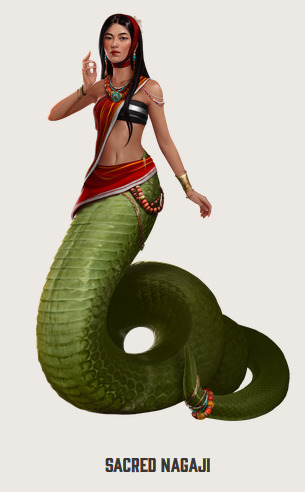
So I'm going to go ahead go with that.
Which brings me to background. I usually do something a bit outcast-ish for a Gorgon Archer, but this feels a bit unnecessary for this character since there's entire snake-people cultures. Plus, again, let's stretch from my normal. (Not that many people have seen my other builds, since I doubt many have seen my old blogger site) but, anyway.
So on to Background. There's a lot for Pathfinder, I don't really want to lean too heavily into the "sacred" thing or the typical monastic monk (sort of a problem with the class being named monk... not all monks are actual monks.) In this case, I'm going to go with Courier.
So that gives us:
Ancestry: Nagaji
Heritage: Sacred Nagaji
Background: Courier
Class: Monk
So, let's get to determining Abilities. The way this works is we get bonuses for each of the following:
Ancestry: Two, usually one set and one free.
Background: Two or one depending on background
Class: One
Since we're going archery, we'll be doing Dexterity where we can.
The nagaji set boost is to Strength and we'll add the free one to Dexterity.
The courier background gets two boosts, one has to be to Dexterity or Intelligence and the other is free. They can't both be Dexterity because you can gain a boost to the same Ability from the same source. I'm taking Dexterity for sure and I think I'll go with Intelligence for the second. Why that and not Wisdom? That'll come up later.
Monk gives us one boosts to either Strength or Dexterity and we'll go with Dexterity.
In addition, at first level we get four boosts each of which has to go to a different Ability. We're going for Dexterity, Constitution, Wisdom, and Intelligence.
This makes the states look like the following:
Strength +1
Dexterity +4
Constitution +1
Intelligence +2
Wisdom +1
Charisma +0
You can actually do these things in whatever order you want, the game has a suggested order, but also are explicit that you can do things in any order. Especially for things that may have requirements. In this case, I'm going to move to Skills next, as that will determine what feats are available.
First, some Skills came with Background and Class
Courier provides the following Skills:
Society
A Lore skill related to the City you're from.
Class provides the following training, not all of these are skills, but I'm including proficiencies as well:
Trained in Perception - most classes seem to start with this.
Expert in all three Saving Throws - seems to be a Monk thing
Expert in Unarmored Defense - Monk thing
Trained in Simple Weapons
Trained in Unarmed Attack
Trained in Monk ability save DCs
Trained in 4 Skills plus Intelligence (+2 here)
10 Hit Points + Constitution per level (that's right, you don't roll HP)
So, I have to pick 6 skills
Acrobatics for maneuvering
Athletics for climbing
Deception for intrigue
Diplomacy for etiquette
Stealth for intrigue
Survival for travel
Now we come to feats. There are four kinds:
Class Feats - abilities particular to your Class
Ancestry Feats - abilities particular to your Ancestry
Skill Feats - abilities particular to your Skills
General Feats - general capabilities
Most martials, Monk included, get a Class feat at 1st level. All classes get a Class feat at each even level afterward.
Characters get one Ancestry feat at 1st level, then it seems at 5th and each 4 levels afterwards, but this seems to be a determined by class, so their may be some classes that get more or fewer Ancestry feats.
Skill feats are definitely a class thing with Rogues getting a Skill feat every level and other classes seeming to get them every even level.
General feats seem to come at 3rd level and every 4 levels after, but again, some classes might be different.
We get one right away because of the Courier background, Glean Contents, which allows her to figure out what papers contain without disturbing seals or with only a quick glimpse. Then we get an Ancestry feat and a Class feat.
Class feat is easy: Monastic Archer Stance. Because we want to be an archer.

Now the Ancestry feat. There's two that stand out, one is Cold Minded, which gives a +1 to saving throws vs emotion magic and Serpent's Tongue which gives the Scent ability. I'm going for the Scent ability in this case to be able to catch awareness of enemies.
That gives us the following end result for 1st level:
1st Level Sacred Nagaji Courier Monk
Strength +1
Dexterity +4
Constitution +1
Intelligence +1
Wisdom +2
Charisma +0
Hit Points: 11 AC: 19
Fortitude +6
Reflex +9
Will +7
Monk DC: 17
Trained Perception: +4
Initiative: +2
Skills
Trained: Acrobatics +7
Untrained: Arcana +2
Trained: Athletics +4
Untrained: Crafting +2
Trained: Deception +3
Trained: Diplomacy +3
Untrained: Intimidation +0
Trained: Lore: City +5
Untrained: Medicine +1
Untrained: Nature +1
Untrained: Occultism +2
Untrained Performance +0
Untrained Religion +1
Trained: Society +5
Trained: Stealth +7
Trained: Survival +4
Untrained Thievery +4
Weapons
Fist +7, 1d6
Tail +4, 1d6
Longbow +7, 1d8
Class Feats
Monastic Archer Stance
Ancestry Feats
Serpent's Tongue - Scent (Imprecise) 30ft
Skill Feats
Glean Contents
Features
Sacred Nagaji Tail - 1d6 Unarmed, Brawling
Sacred Nagaji stability +2 to Fortitude and Reflex saves to resist Grapple, Trip, and other similar abilities.
Flurry of Blows
Low-Light Vision
Powerful Fists
That's it for 1st level done for. I'm going to continue on to 4th level however, to reach for an important bit for the gorgon concept: snakes for her. Granted, we can just describe her as having snakes for hair, but when the option to represent something mechanically, I'll take it and since I can't do more than fluff it at 1st level, I'll move on to 4th.
2nd Level
For the second level, we get into how Pathfinder does multiclassing. It does it, as it does most things, through feats. We're going to take a Dedication Feat for the Witch class, which is why we wanted Intelligence at +2 to meet the requirements.
Dedication Witch gives the following:
A patron
A familiar which knows two Cantrips.
The ability to prepare one Cantrip per day.
Training in a skill based on patron.
For patron, we're choosing Spinner of Threads, feels like that goes in with intrigue a bit. This means she gains the Occultism skill and gains spells from the Occult list. For a familiar, we're going with a sparrow.
For the two cantrips, Approximate and Message. She'll probably prepare Message on most cases. But Approximate would be useful for some investigations.
She also gains a Skill Feat and I'm taking Streetwise so she can gather information through Society instead of Diplomacy.
3rd Level
At this point, we gain our first General feat. As a note, when you get a General feat you can instead take a Skill feat. In this case, I'll take a General Feat, Incredible Initiative so that she gains +2 to initiative. Initiative usually uses Perception, but you can make a case for using other skills, such as if you're being very stealthy (Stealth) or start with a battle cry (Intimidate)
She also gains the following Monk features:
Mystic Strikes so her unarmed attacks (and bow attacks while in Monastic Archer Stance) count as magical.
Incredible Movement so she gets +10ft to Movement and +5ft for every 4th level after.
We also get to increase a skill. We could increase one of our skills to Expert, but instead, we'll take another skill to complete our intrigue concept: Thievery.
4th Level
Now we get to another Class Feat which is going to be "Archetype Feat" which are basically the multiclass feats. And we're going to take the feat we dipped into Witch.
We taking Basic Witchcraft, giving us a 1st or 2nd level Witch Class Feat, which will be Witch's Armaments. That gives us a choice between claws, fangs, or living hair. We're obviously going for living hair.
Now, we take a Skill feat which will be Ambush Tactics, which means she has a good eye for spotting ambushes within a terrain she has a Lore for... Cities.
And now at 4th level we have our Gorgon Archer. You'll note that AC has gone up. Level is part of all calculations, including AC, Attacks, save DCs, and Skill bonuses. Untrained skills do not increase so they would just use base Ability score.
I'm also going to say right now that going for Living Hair is not optimal, but it is a good flavor and what I'm looking for. Also, the hair, while a weak attack, has traits making it useful for disarming, tripping, grappling, and is also agile, meaning it doesn't suffer from multiple attack penalty as badly.
4th Level Sacred Nagaji Courier Monk
Strength +1
Dexterity +4
Constitution +1
Intelligence +1
Wisdom +2
Charisma +0
Hit Points: 54 AC: 22
Fortitude +9
Reflex +12
Will +9
Monk DC: 20
Trained Perception: +7
Initiative: +2
Skills
Trained: Acrobatics +10
Untrained: Arcana +2
Trained: Athletics +7
Untrained: Crafting +2
Trained: Deception +6
Trained: Diplomacy +6
Untrained: Intimidation +0
Trained: Lore: City +8
Untrained: Medicine +1
Untrained: Nature +1
Trained: Occultism +8
Untrained: Performance +0
Untrained: Religion +1
Trained: Society +8
Trained: Stealth +10
Trained: Survival +7
Trained: Thievery +10
Weapons
Fist +10, 1d6
Tail +7, 1d6
Longbow +10, 1d8
Living Hair +10, 1d4
Class Feats
Monastic Archer Stance
Witch Dedication
Basic Witchcraft: Witch's Armaments: Living Hair
Ancestry Feats
Serpent's Tongue - Scent (Imprecise) 30ft
Skill Feats
Ambush Tactics
Glean Contents
Streetwise
General Feats
Incredible Initiative
Features
Sacred Nagaji Tail - 1d6 Unarmed, Brawling
Sacred Nagaji stability +2 to Fortitude and Reflex saves to resist Grapple, Trip, and other similar abilities.
Flurry of Blows
Low-Light Vision
Powerful Fists
Witch's Patron: Spinner of Threads
Mystic Strikes
Incredible Movement
Occultism Witch Cantrips: Approximate, Message
I thought I was going to stop here, but I'm going to go ahead and push to 20th because Medusa's Wrath happens at 16th level and when I've gone that far, might as well go to the end. On my blogger, I'd do summaries every 5 levels. Instead, I'll just do the level up decisions and then summarize at 20.
5th Level
This is one of the few levels that only comes with a single Feat. In this case it is an Ancestry Feat. For this I'm taking Nagaji Spell Familiarity which gives her a list of three cantrips she can choose between preparing each day. These are Daze, Detect Magic, and Mage Hand.
This level also comes with a Skill Increase and four Ability boosts.
For the Skill Increase I boost Society, and for the Ability boosts I choose: Dexterity, Constitution, Intelligence, and Wisdom.
Dexterity doesn't go up here because once you get to +4 it takes two boosts to go up. So I'm going to buff up my lower Abilities a bit first. Boosting Intelligence gives her another basic skill training, for that I chose Medicine.
At this level, her Perception, Unarmed attacks, and Monk attacks (like bows) are now up to Expert proficiency.
6th Level
Now we get another Class feat and a Skill feat. For this I'm choosing:
Ki Strike - our first Focus spell
Forensic Acumen - now that she has training in Medicine, more intrigue
Now we have to choose whether her Ki spells are Divine or Occult and I'm sticking to theme and going with Occult.
7th Level
At this level we get a General feat a skill increase and the first Path to Perfection. That's basically a choice of a saving throw to increase. Now, Pathfinder has retraining, but the third path goes to Legendary while the first two go to Master. I'm going for Reflex at this point.
For the General Feat, I'm choosing Feather Step, allowing her to Step into difficult terrain, which is normally not possible. For the Skill Increase, I'm going to increase Deception to Expert.
At this level, she also gains Weapon Specialization, adding damage to weapons and unarmed attacks.
8th Level
At this level we get another Class Feat and a Skill Feat, for these I'm choosing:
Pinning Fire - Letting her immobilize a target she hits twice with a Flurry of Blows from her bow.
Eyes of the City - letting her use Society to Gather Information instead of Diplomacy
9th Level
At this level we get a Skill Increase, an Ancestry Feat, Monk abilities increase to Expert, and Metal Strikes so that her unarmed and bow attacks (while in Monastic Archer Stance) count as Cold Iron and Silver.
Skill Increase: Society
Ancestry Feat: Guarded Thoughts - making it hard to read her mind.
10th Level
At this level we get another Class and Skill feat, and four more Ability Boosts.
Ability Boosts: Strength, Dexterity, Wisdom, and Charisma
Class Feat: Ki Rush - burst of quick movement
Skill Feat: Biographical Eye - this is the Sherlock Scan
11th Level
At this level we get a General Feat, Skill Increase, and the second Path to Perfection.
General Feat: Ancestral Paragon for a bonus Ancestry Feat
Ancestry Feat: Nagaji Lore
Skill Increase: Deception
Path to Perfection: Fortitude
Now, Nagaji Lore comes with a couple of things:
Training in Occultism and Crafting, but she already has Occultism, so instead we take Intimidation
Training in Nagaji Lore
12th Level
Another Class feat and Skill feat.
Class Feat: Elemental Strikes - adding elemental energy when using Ki Strike
Skill Feat: Lie to Me - ability to trip people up that try to lie to her.
13th Level
At this level we get another Ancestry Feat along with her weapons and unarmored defenses becoming Master in proficiency.
Ancestry Feat: Disruptive Stare, to make enemy spellcasters have a tougher time.
14th Level
Another Class and Skill Feat.
Class Feat: Focused Shot - lets her ignore cover and concealment.
Skill Feat: Quick Jump - lets her jump quicker
15th Level
Now we get one Skill increase, one General Feat (which I will turn into a Skill Feat), the third Path to Perfection, and Greater Weapon Specialization.
Ability Boosts: Dexterity, Intelligent, Wisdom, and Charisma
Skill Increase: Society, now it's Legendary
General/Skill Feat: Legendary Codebreaker
Third Path to Perfection: Will
Increasing Intelligent gives us another basic Skill Training. And I'm taking Performance for that.
16th Level
And here we come to finally getting Medusa's Wrath because it's a new Class Feat and a Skill Feat.
Class Feat: Medusa's Wrath
Skill Feat: Slippery Secrets - so it's harder to catch her in a lie.
17th Level
At this level we get an Ancestry Feat, her unarmored defense advances to Legendary, and her attacks count as Adamantine.
Ancestry Feat: Nagaji Spell Mysteries. Allows her to prep Charm, Fleet Step, or Heal once per day.
18th Level
And now we get another Class and Skill Feat:
Class Feat: Diamond Fists, since Monastic Archer Stance causes these abilities to affect her archery, it carries over. Each successive hit she makes in the same round does more damage.
Skill Feat: Doublespeak, the ability to say one thing and mean another.
19th Level
Now we get a Skill Increase, General Feat, and Perfected Form which basically means she can't roll less than a 10 on her first strike each turn.
Skill Increase: Thievery
General Feat: Reveal Machinations
20th Level
The last Class and Skill feats. The level 20 Class feats are the typical capstone abilities and for this case, I'm taking Enduring Quickness which basically gives her an additional action every round purely for movement. I'm running out of exciting things for Skill Feats though.
Class Feat: Enduring Quickness
Skill Feat: Underground Network
The final build is this:
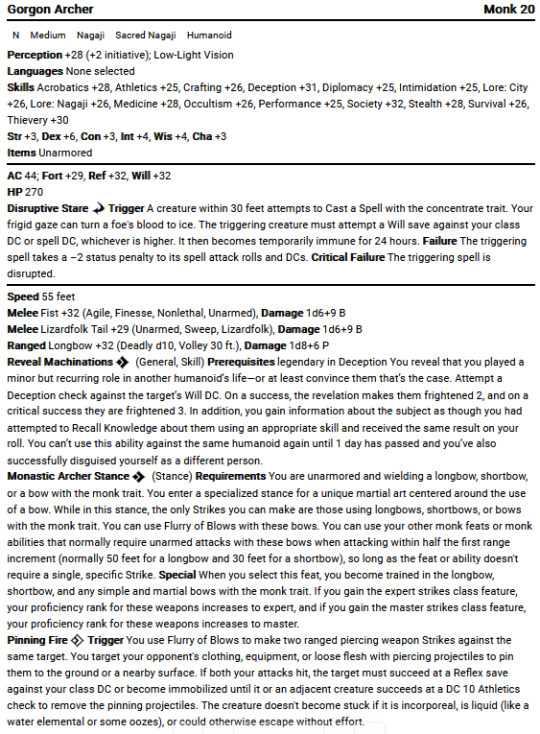
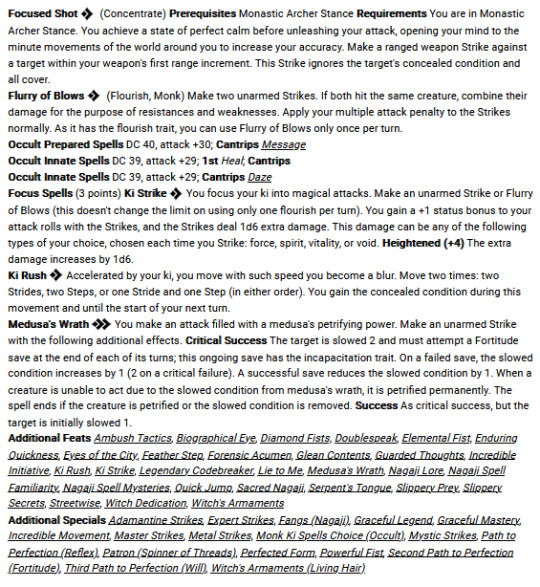
#character creation#ttrpg#gorgon archer#gorgon#pathfinder 2e#archer#tabletop roleplaying game#fantasy#character creation and the gorgon archer
0 notes
Text
Adding some more Little Guys (gender neutral). I was gonna just update this post but turns out I had two too many Little Guys so here's the new ones. Most of these were multi-session.












Top row, 2nd batch:
Abby, Liminal Horror; Subject Aflame cashier.
Abby, my beloved! Our Liminal Horror game is on indefinite hiatus (as is our Shadowrun game) [edit: BACK ON, and the Liminal Horror oneshot is FINISHED as of 7/15/2024, we survived!] but I've enjoyed playing Abby as the mall she works at is overtaken by otherworldly monsters. IIRC she's like... 17? and others would describe her as "artsy" but her primary talent is drawing one anime eye really well. She isn't very good at handling scary things, but she is pretty good at figuring shit out, so she thankfully was spared the horrifying thing that the rest of the team saw last session, which I will not go into because it actually was pretty awful. [edit ii: I have updated her row to include a pic of her filthy and emerging from the belly of the beast (fortunately not literally) having helped her allies destroy the horror that was overtaking the mall.
2nd row:
Veronica (???), FASA Doctor Who Roleplaying Game; scientist from near-future Earth.
I'm not a hundred percent sure I got any of her right -- this was a character the GMs at Chicago TARDIS provided for their double-GM extravaganza. I am pretty sure I got her color scheme right, though, because I remember the GMs saying some of the character sheets they were passing out were based on their Power Rangers campaign and I was like "okay she must've been a purple ranger because everything she's wearing is purple." Anyway, I really enjoyed this game but I'm really glad the other half of the team were the ones playing the Jenga minigame because we got to do the blindfolded maze part instead and that seemed way less precarious. The villains were two incarnations of the Celestial Toymaker and they kept turning our equipment into toy versions, hence the balloon crossbow. 3rd row:
Eberswind, Pathfinder 2E; dwarf ranger (and Hubert).
So the Pathfinder campaign I'm in now is set during a magically prolonged eclipse and the sun has been gone for like. five months. Needless to say, it is very cold. Eberswind, my character, is really fun to play because she's just extremely practical and cynical and SO ANGRY. Prior to being an adventurer she used to run a restaurant which had been in her family for generations, and is an excellent cook, but unfortunately food is hard to come by these days so she brushed up on the hunting skills she acquired in her youth, and also the occasional breaking-and-entering skills she acquired before her family sent her to the countryside to learn to hunt and to keep her out of trouble.
The owl's name is Hubert. He is bigger than that in the game, but Heroforge only has one size of owl. I think Eberswind rescued Hubert from some extremely dumb situation he got himself into and then he refused to leave when he had recovered because why would you leave someone who feeds you and lets you stay inside with them??? So, here he is.
4th row:
Danny Kilpatrick, FASA Doctor Who Roleplaying Game; former mob accountant from Chicago, 1926.
There were a handful of oneshots offered at Chicago TARDIS and for most of them you could play a character you came up with. They cautioned us against playing a character from an alien planet or a historical era because while obviously that's very cool if we were just sitting down to create a character it might be really hard to come up with something if we didn't know a ton about the world/era they were from. And I was like "Well. I know a guy. Also I can do his accent, which is more than I can say for every other character I've ever roleplayed." Had a lot of fun with this one -- Danny got to reunite someone with her lost sister and turn off a big evil machine everyone was trapped in! Also, the guy I sat next to had never played before and I was happily able to help him, having gotten through the double-GM game the night before, and then I found out he'd never played a TTRPG at all, so that was really cool and I hope he had fun.
5th row:
Kikka, Shadow of the Demon Lord; Changeling academic-turned-Priest of the Old Faith.
Shadow of the Demon Lord is the edgiest thing in existence and it's so fucking dumb in some ways, but I enjoyed this character. Partly, so, it's one of those games where you roll randomly for a bunch of stuff most games would let you choose, and the funniest thing happened which is that I decided to play a Changeling and then all her appearance attributes came up as 100% normal and unremarkable, so I decided she had spent her life blending in and being Very Normal and Totally Human, and she was the only normal-looking person in the party. Anyway, you don't get to pick a character class until you've survived the first session, so I decided to just go wildly in the opposite direction from that and make her basically a werewolf druid, because when you have survived a zombie attack you should get to do whatever the fuck you want and not worry so much about conformity.
6th row:
Vitus, Fabula Ultima; Entropist/Tinkerer.
So ages ago back when I was writing Harry Potter fic set in the early middle ages, I came up with this cranky vampire character who I wanted Godric to interact with; his deal was that he had been a Muggle and a Roman military engineer and the stupid vampire council (there is always a vampire council, you gotta have a vampire council) had sent him as a neutral observer to watch a magical war Godric found himself imprisoned by one side of, and he thought the whole stupid vampire council was stupid as fuck and shouldn't be in charge of anything, and he missed being able to eat things with garlic and he missed indoor plumbing, and he decided he liked Godric's eminently sensible attitude of "I don't want to be here, I don't even understand what everybody's fighting over, I just want to be at home marking papers," and he helped Godric escape. Anyway, then I decided maybe I shouldn't write him into a Harry Potter fic because I had enough show-stealing OCs in that fic. But I kept him in my back pocket for later. So, later, my one-shot group ended up playing Fabula Ultima, a JRPG-inspired TTRPG, and I decided to bring this concept out.
Anyway, instead of being a vampire, he's immortal through other means -- being an Entropist allows him to take life force from enemies, and I decided he had been in some kind of entropic accident that left him Like This, but he's very annoyed about the whole thing. All these magitech lying in ruins just shows how important stress testing and quality control are, because this shit is legitimately hazardous centuries later, and these modern people don't even know how to make ROADS, ugh. Anyway, he lost all his HP in battle but you can't actually die in Fabula Ultima unless you choose to sacrifice yourself to do a ton of damage in battle, but he already did a ton of damage and I liked him as a grumpy immortal so he just kind of got the shit kicked out of him, which seemed much funnier.
7th row:
Chris Kolettis, Vampire: the Masquerade 5E; Ventrue, 57th ward alderman.
First of all, there is no 57th ward. I'm basing it on the 46th ward, where I live, but I didn't want to deal with real specific locations since our GM doesn't live here and shouldn't have to feel like he's got to describe real locations. Second of all, I swear to fuck I didn't pick the setting, we ended up with a game set in '90s Chicago completely without my influence. Anyway, we just had our first session of this game and we decided that Chris is actually the (non-vampire, actual real human) uncle of one of the other vampires, and because Chris is big on family, even though his nephew is an angry rebellious caitiff (an unaligned, clanless vampire) he has tried to be very supportive and helpful and is annoyingly protective. This may become awkward if Chris finds out his nephew is drinking the blood of other vampires, but that's a problem for future Chris.
Ventrue as elite, politically-minded vampires have specific feeding restrictions and I decided it would be funniest if Chris could only feed on his constituents, so he doesn't eat anyone who is not an adult of voting age, who doesn't live in his ward, or who, to his knowledge, is registered to vote as a Republican. (This says absolutely nothing about his political beliefs; the point is he belongs to the political machine at least as much as he belongs to Clan Ventrue.)
I'll probably make a more interesting second pose/screenshot for him once I've played him again, but since I know there'll be a second session he's got two screenshots. (Also, hey, he's wearing Chicago colors!) TBH I probably should have made the second pose either him being knocked out or him losing at a video game or him doing a I AM SO PROUD OF YOU pose with his nephew but I don't think there are modern chairs in Heroforge for him to sit in to lose at a video game and I didn't wanna make a whole other figure, and him being knocked out was very funny in-game but I didn't want to imply he died. So he's getting mad at someone over the phone in the '90s.
8th row:
Hideko (whose surname I've forgotten argh), Yokai Hunters Society; a playful and unforgiving artisan who wears an Otafuku mask.
In Yokai Hunters Society you play a masked vigilante monster hunter in Meiji-era Japan. I decided I wanted to play an artisan and then decided she was a netsuke carver and then I was going to figure out some kind of yokai-related backstory that had a complex sociological tie-in for why she was in this organization, but then I came across the category of yokai that is tsukumogami -- objects that have been neglected or treated badly -- and I decided her family had been terrorized by the ghost of an old futon and she wanted revenge because that was both much funnier and much more relatable. I too have kept futons for too long, but fortunately they didn't keep me up by having loud parties, just by being horrible for my back.
Anyway, here she is crawling through a narrow passageway brandishing our disgraced samurai's Very Good Lantern (it was like a +3 to rolls iirc) and a very average knife we found in the kitchen of the haunted house.
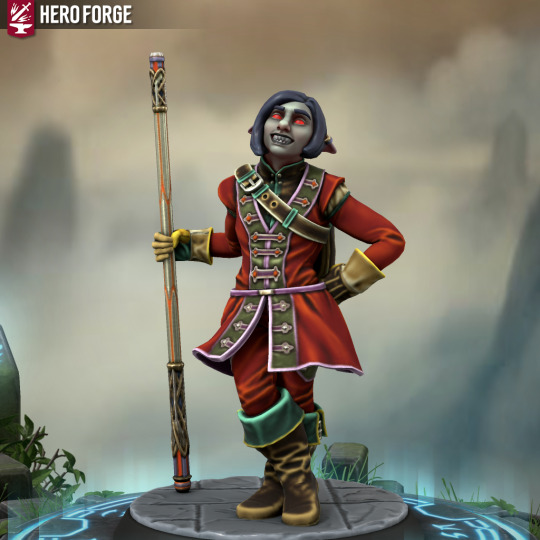

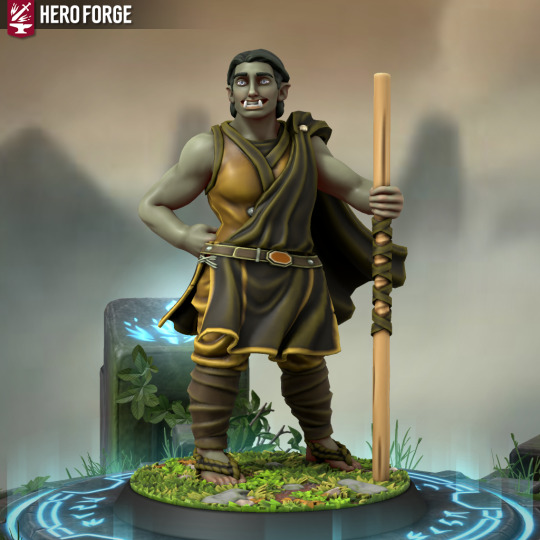
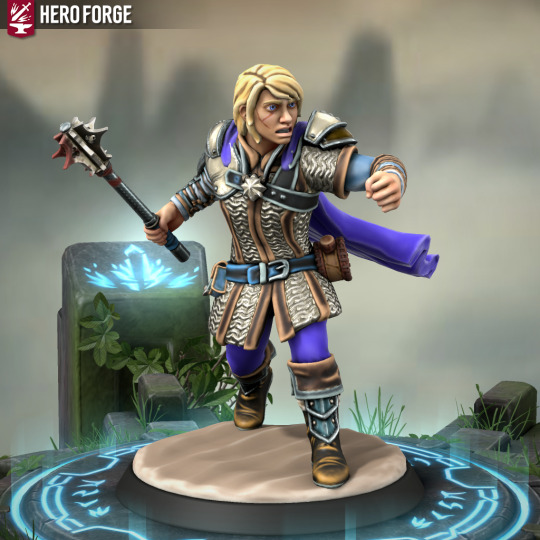
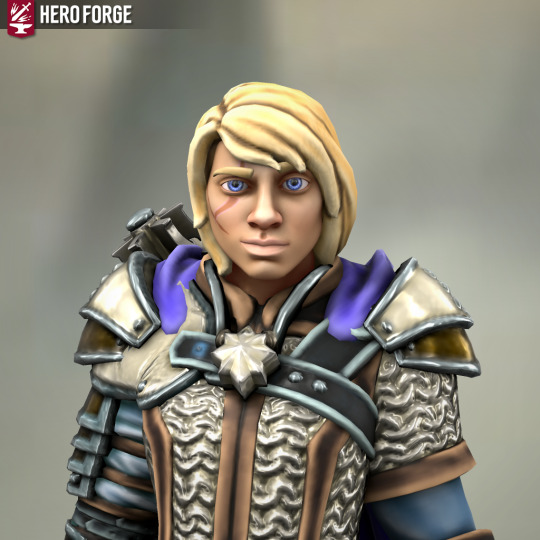
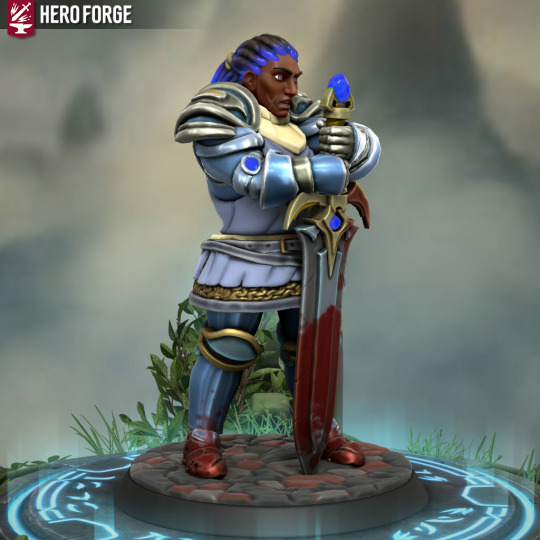

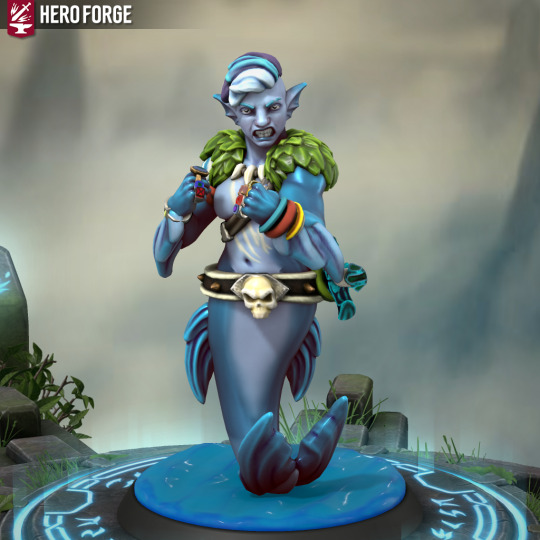

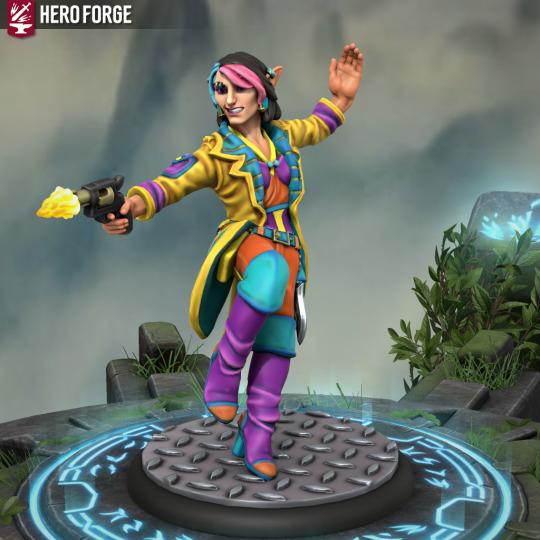

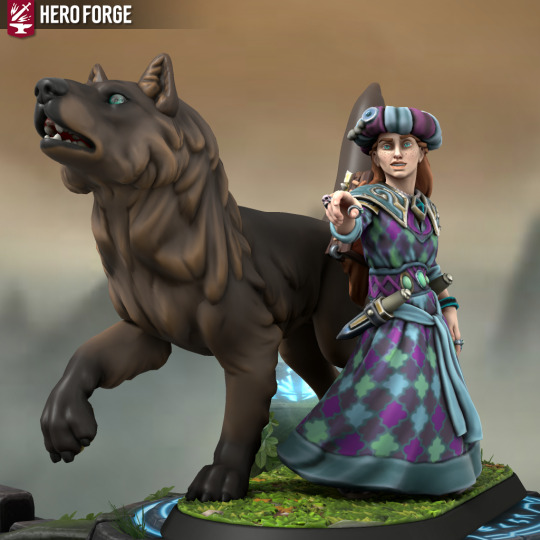
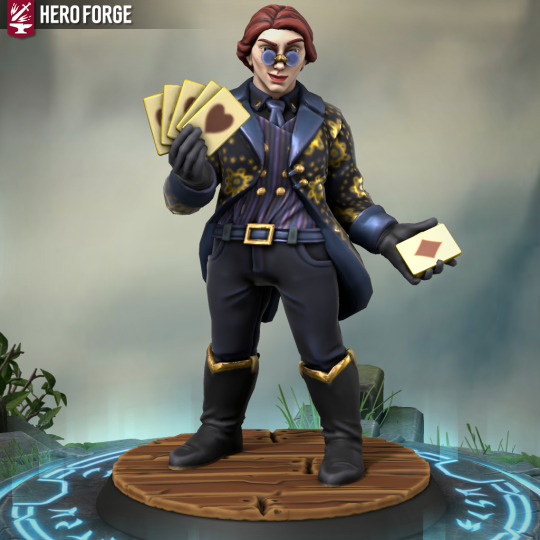
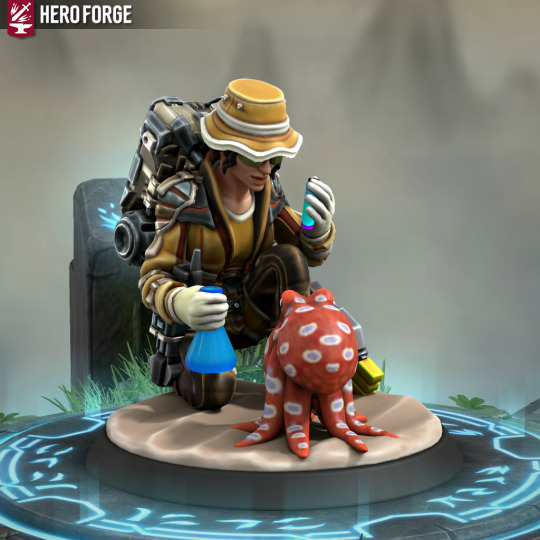



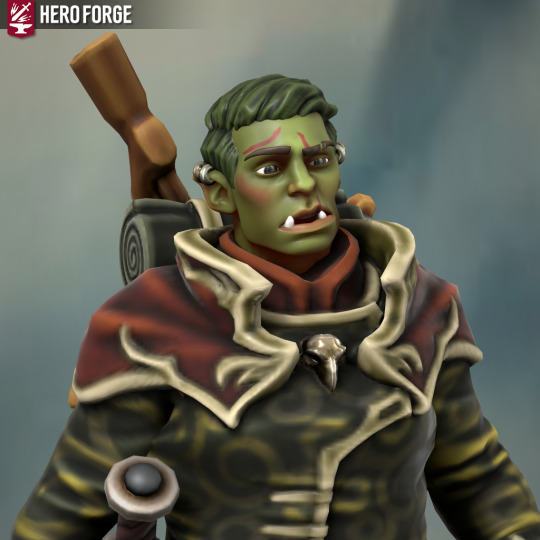
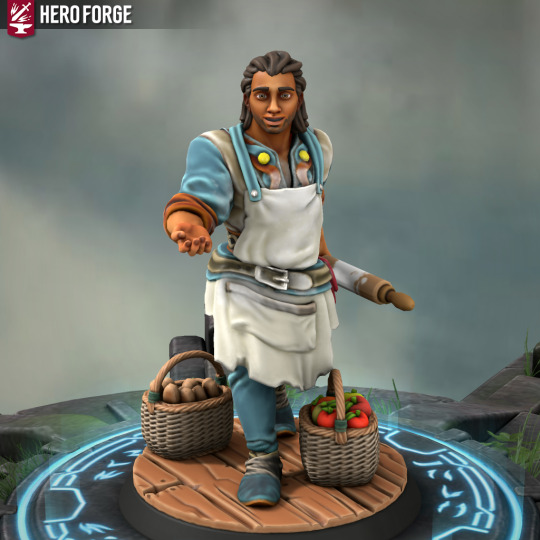
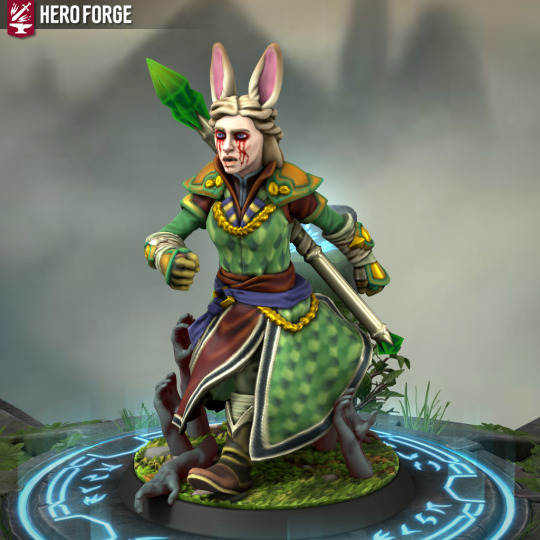
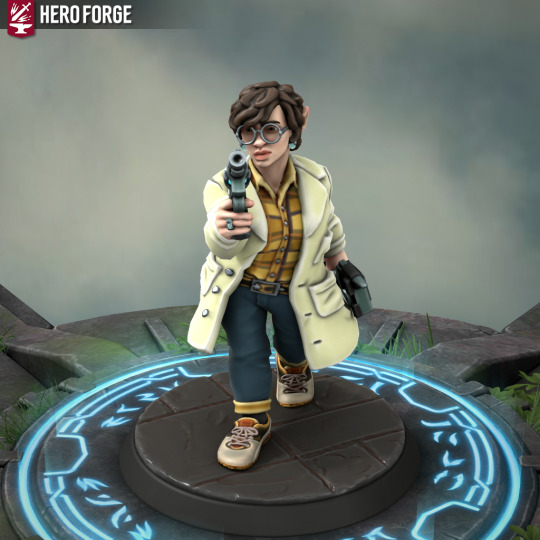
Made little Hero Forge guys out of every single character I've ever played at least one session of in a TTRPG. (The ones with closeups I've played for more than one session.) Details under the cut.
Top Row:
Literally Just Terezi Pyrope, Pathfinder; half-orc Investigator Made for a Pathfinder oneshot wherein my friend was playing a Vriska-inspired character. I feel the need to disclaim that we did not kill or maim anyone out-of-game. I don't even remember if we killed anyone in-game because I remember it being pretty puzzle/trap-focused?
????; Ryuutama; Crafter/Autumn Sorceress I'm kicking myself that I don't remember her name. She was a seamstress, and in the specific world we were playing in we were the descendants of space colonists, so I decided her ancestors would be from a culture with really pretty fabric patterns.
Ylva Truehand, D&D 5E; half-orc monk. A herbo if ever there was one. Accidentally became the figurehead of a coup d'etat at home and had to Leave Right Now Immediately. We only got to the part where we all met at an inn before outside circumstances meant the campaign fell apart.
2nd Row:
Katja, 3.5E D&D; human cleric prestige class (maybe a Radiant Servant of Pelor?) My very first TTRPG character! I played her in a high school friend's historical-fantasy-inspired homebrew setting campaign he ran one summer in college. She was meant to be an army doctor for Fantasy Imperial Russia and we were doing an escort mission across a desert that was, iirc, disputed territory between three superpowers? Mostly I remember killing a lot of ninjas and then stumbling across a magical oasis where the water was magically pacifying, finding the mineral that was responsible for this effect, grinding a bunch of it into powder, and then making our GM's life a living hell by slipping it into NPCs' drinks whenever we wanted something from them.
3rd Row:
Safira, Stewpot; Paladin/Artisan. This one's pretty obviously an expy of my angel OC Vehuel. Stewpot is a game about retiring from adventuring so the character concept for her was "Holy warrior chosen by prophecy to kill a great evil with a magic sword; accidentally fell in love with the great evil. Eventually killed it anyway. Deeply traumatized."
Yarrow Tunneler, Mausritter; Acorn sign wireworker. Yarrow came out so cute here! A lot of stuff in Mausritter is randomly assigned and I think her class was one of those things, but I liked the wireworker thing (basically she's a mouse electrician) and one of her starting bits of equipment was a spool of wire. There weren't any good wire spools on Hero Forge, but I managed to make a battery-looking thing for her to carry around on her back.
Esca Glowfin, Ocean Tides; mermaid. Yeah so the game wanted me to choose whether she was going to be a mermaid or pirate but I wanted to be both so I made it work. The actual character concept I had in my head does not look much like this but turns out one of Hero Forge's weaknesses is deep sea benthic horrors with needle teeth. So I just made her hot. Sorry, Esca, you probably deserved better.
4rd Row:
Minu Darzi, Shadowrun 5E/Definitely Not Shadowrun At All; elf face. This one's an expy of my demon OC Nisroc, but like, a very very tiny sliver of Nisroc's whole schtick. I tend to describe her as "what if Grendel's mother was a shitty grifter who wanted to be an influencer?" but she shoots a lot of people so I feel like her sphere of influence is powerful but limited to like. Influencing people to die.
5th Row:
Royse, 5E D&D; Aasimar rogue. Another Vehuel expy, this one much younger and less traumatized. Royse was made for a West Marches group I didn't really vibe with. The one session I played was great but the out-of-game downtime stuff felt like a part-time accounting job and I don't have any interest in accounting. Anyway Royse was fun and she was gonna be a Swashbuckler.
Pandora (& Scylax), Worlds Without Number; mage (Necromancer/Beastmaster). For the oneshot group I'm part of we've started doing a test combat session at the end of Session Zero to make sure our characters aren't going to die immediately, and after that our GM decided we should be using the Heroic rules. In the combat trial, Pandora used her one (1) spell slot to mind-control one of the wolves that were attacking us and it killed a bunch of the rest of them, so given the opportunity to add another 1/2 mage specialization I picked Beastmaster and gave her a wolf. I really liked some of the lore for this game but oof, it's super unforgiving. (I think it might be a good starting point if you wanted to play a Locked Tomb campaign, though?)
Zamira the Magnificent, Blades in the Dark; slide. This character was a disgraced stage magician who accidentally killed her assistant (maybe sawed them in half?) and I liked the concept but our Blades in the Dark party really didn't end up doing much RP, even though we are a very RP-heavy group; I kind of wish the game had facilitated it more.
6th Row:
????; Tempus Diducit; Weird Scientist. Tempus Diducit is a no-prep chaotic game about a time travel crisis where a lot of things are randomized; mostly I remember there being superintelligent octopi and making strong acids, and also me having a lot of very annoying ideas involving my specialized knowledge of both cephalopods and chemistry.
????; Subway Runners. I remember very little about my Subway Runners character but basically this is a no-prep game where your character sheet is entirely randomized and every character is probably at least a little Done With This Shit because every Subway Runners PC is a gig economy worker whose shitty gig job is fixing an urban fantasy public transit system full of extremely weird shit. I think by the end of the session all our characters had cat ears.
Miriam; You Awaken in a Strange Place; marine biologist. Once more my specialized cephalopod knowledge comes back to bite me in the ass! (Also, this is the second Miriam on the list; 'Zamira the Magnificent' was a stage name.) YAiaSP is another no-prep chaotic game; you also get to make up all the skills your characters have, and Miriam was good at Identifying Marine Animals but bad at Working Under Pressure, which was great because they were in a locked submarine murder mystery and identifying marine animals was basically of no use whatsoever. I think in the end she failed a Using Scientific Equipment roll and then bluffed that she had actually gotten the DNA results to get the murderer to confess. This is unethical if you're in law enforcement; if you're a professional marine animal identifier it's still unethical but I think it's also kind of impressive. Only I forget if it actually worked, so maybe it wasn't.
7th Row:
Heshky, Pathfinder 2E; half-orc investigator. I have literally only ever played half-orc investigators in Pathfinder, which is very funny to me. [Edit: This is no longer true! I have a dwarf ranger now.] Heshky here is not much like the Terezi expy, though. He is an expy, but of one of my OCs rather than someone else's and his backstory is that he's a former mob accountant whose boss died in circumstances that were technically not his fault, so he had to leave town for a while. I would absolutely love to play him somewhere else; he was made for my one-shot group but we ended up stretching that Pathfinder one-shot out to like 5? 6? sessions and I got very attached. (If I played him again I miiight not start him out as an investigator though, because he almost died like 3 times.)
8th Row:
Zirane, I'm Sorry, Did You Say Street Magic, baker. ISDYSSM is a cooperative worldbuilding game so I kind of forgot there was a character I played in it, but apparently I did! This guy lives in a fantasy city and works at a cafe owned by some mystery person (possibly a vampire?) but he's not worried about that. He is good at baking, but likes experimenting with weird combinations of flavors, which sometimes means his extremely well-made baked goods taste regrettable.
Kjersti, Session Zero; war-witch deserter. Session Zero is a character creation/development game without character classes; it can actually be played solo as a writing exercise too! So I just kind of went wild here. I really like the concept I ended up with and keep meaning to post what I wrote up for her; over the course of the game she went from annoyed arcane college student to spoiled rich girl to army deserter trying to survive a magical war crimes-induced apocalypse and daydreaming about overthrowing her own government in no time at all.
Edie, Genesys; dwarf mad alchemist. The setting we decided on for the Genesys one-shot was cyberpunk fantasy, a bit like Shadowrun but if magic had always been in the world, so I decided to pull out one of my old, old LJRP characters (Ed Espis) and repurpose her. Edie grew up a third- or fourth-generation corporate citizen and very privileged, but when her parents died under mysterious circumstances and she was fired shortly thereafter, the company decided she had to pay off all the resources they had invested in her entire family so now she's broke and has to do crimes (petty) instead of crimes (war) to live. She ended this session by shooting a guy in the head but listen, he extremely deserved it.
6 notes
·
View notes
Text
Apshai (Egyptian Power)
Apshai is a God that occupies a strange position within Planescape’s Egyptian Pantheon. You see, Apshai is a God that doesn’t exist. Let me back up and explain.
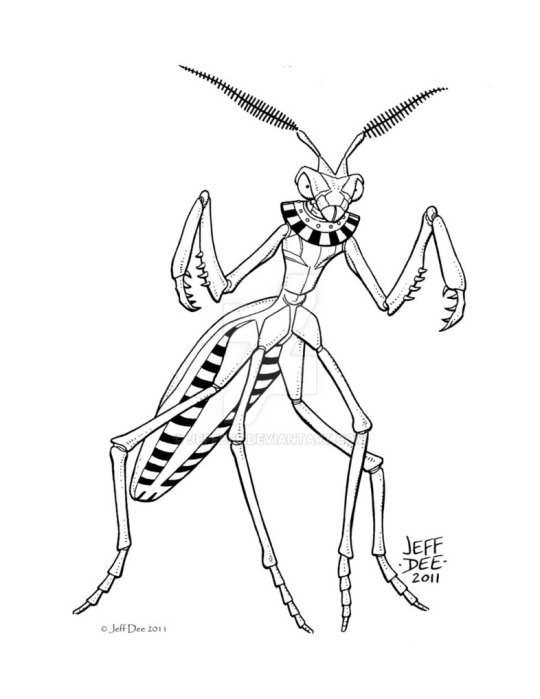
Art by Jeff Dee
It is TOUGH to track down any information on Apshai. The name is Egyptian, it appears in the Papyrus of Ani, one of the most famous and well-studied copies of the Book of Going Forth By Day or — as you may know it — the Book of the Dead. In the Papyrus, Apshai is very clearly not a God. The relevant spell in the Papyrus is Spell 36, which wards Apshai away from the mummified body. A scarab beetle follows Apshai’s name, not one of the hieroglyphs signaling a deity,. The scarab indicates that Apshai was not a god, but an ordinary beetle that decomposed and/or laid its eggs in carrion.
Apshai-as-a-God was an innovation of First Edition’s Deities & Demigods, which I don’t mind since Apshai is a demigod. It’s not true to the mythology at all, it is allows for the interpretation of Apshai as a divine monster, which seems reasonable. Also, he got a stat block and a whole two sentences, so it’s not like the writers took massive liberties. This is where is mantis form came from since all the Egyptian references to Apshai peg him as a beetle.
Second Edition’s Legends & Lore skipped Apshai, but he reappeared in Planescape’s On Hallowed Ground, which granted him a divine domain called The Hive underneath the Outlands. Before that happened, someone else got their hands on the Great Mantis. The Real Ghostbusters featured Apshai as the villian in its final episode as he tries to take over New York with an army of giant insects. This can’t be a coincidence, I mean, look at him…

There is one other place Apshai exists as a praying mantis, so it kinda looks like the plot of this episode must be from someone’s campaign. Again, not something I mind since this a demigod created whole cloth for the Great Wheel. If I’m going to use it for inspiration, I’d say that Apshai — in addition to being a God of insects — is a God of ghosts. That also works with the original Egyptian aspect of the apshai beetle as a corpse-eater, the ghosts in the Hive are the souls stranded there when beetles consumed their bodies, unanchoring them.
(Yes, I know ghosts can’t exist on the Outer Planes in 2e. I’m ignoring it.)
We also know that farmers worship Apshai, although most of that supplication is requests that he keep locusts away from their crops. If I were to give Apshai Pathfinder 1e domains, I would say he has Animal, Earth, Death, and Plant; with the Caves, Decay, Insect, Plagues, and Undead subdomains. It occurs that this is thematically similar to the Golgari Swarm, which I am down with. Creepy Green-Black neutral deities for the win!
The Hive is a “safe” distance from Ilsensine’s domain, the Caverns of Thought, but nowhere is safe from the hoards of cranium rats the Caverns disgorge. One way for adventurers to get on Apshai’s good side and gain safe passage through the Hive is to hunt down the rodent invaders.
The Kemetic faith neglects Apshai as it is, but he recently gained a new group of supplicants. A colony of entothropes in Sigil, mostly weremantises, worship him in a small pantheon alongside Achaekek and Deskari. Apshai is still the least popular of three, but his rangers and druids are more welcome on other planes, allowing them to serve as traders and envoys.
Anubis, son of Ra, Guardian of Dead Gods, made a disturbing discovery patrolling the Astral: beetles have infests several stone deific corpses and consumed them from the inside out. Now he recruits heroes to discover how this happened and to answer an even more pressing question — what does Apshai want with the ghosts of dead gods?
Notes: I’m less familiar with 5e domains, so those are trickier, but I’d say Apshai grants some combination of Death, Grave, and Nature. If I were to port him over to Scion, I’d give Apshai the Hunter, Liminal, and Trickster Callings; and the Beasts (Insects), Death, Earth, and Wild Purviews.
27 notes
·
View notes
Text
Horizon Walker (Pathfinder Second Edition Archetype)

(art by amirzand on DeviantArt)
It’s been a while, but we’ve come back to another “Former 1E prestige class turned 2E archetype”!
This time, we’re dealing with the horizon walker, a specialist in traversing all manner of terrain, a legendary figure that is home anywhere they go, and able to lead others with a certainty that can rarely be matched. Theirs is a true bond with the land.
Of course, we can’t bring up a holdover from 1E without comparing the two, so let’s get that out of the way.
The former horizon walker was very much an expansion of the favored terrain mechanics of the ranger taken to the extreme with even supernatural abilities becoming available, particularly if the favored terrains were themselves supernatural, such as planar landscapes.
This new version, however, doesn’t really feature access to planar terrain, and any supernatural abilities they might have had are more generalized, useful minor spells for traversing and surviving in the wild. Instead, their abilities are more specific to surviving and guiding others through the wild, though they do get some combat tricks too.
The good news, however, is that unlike the former version, the horizon walker is available and useful to all classes. If you yearn to play a Gandalf-esque wandering wizard that has been everywhere and seen everything, this archetype could be what you need. Or perhaps you’re a hermit monk or psychic that lives alone in the wilds seeking enlightenment, or something more expected like a ranger, fighter, or barbarian. All are possible. That being said, ranger has the natural advantage because of how the wild stride class feature interacts with the dedication, something other classes will need to take one of the horizon walker feats later for.
No matter what your starting class is, however, horizon walkers represent an utter mastery and bond with the land unmatched by others, and they may indeed be local legends or just someone that everyone in a vast area knows.
The core dedication of horizon walkers gives them mastery over a terrain of their choice, making them swifter in it and able to move and guide others without being hindered by the terrain. Additionally, if they possess the wild stride ability, they gain additional benefits, which range from resistance to the extreme temperatures to gaining new movement types with greater speed.
Horizon Walkers learn to acclimatize themselves to the terrain, becoming resistant to the local environmental hazards and ignoring the extremes of temperature. What’s more, they can coach others to do the same.
Many also make a mental map of their surroundings constantly, and are able to use it to remember good distraction points and hiding spots in a moment’s notice.
Tricky terrain and the properties of such are important things to understand for these wanderers, and they do, being less likely to slip on ice, or flounder in water, or grab a loose handhold when climbing.
True to their nature, these travelers make excellent scouts, and can do so even when doing other activities as they travel, being keen to notice anything out of place in their favored terrain.
Of course, the horizon walker isn’t just all scouting and wandering. Some apply their familiarity with the world around them to better fight foes that they cannot effectively perceive.
Many also pick up magical tricks for emergencies, namely giving themselves darkvision, the ability to climb any surface, and breathe underwater.
While at first they only master one terrain, true masters learn to take the time to absorb as much information about the terrain as possible and master a new terrain for as long as they remain in it.
Most also learn not just to guide allies in traversing in the wilderness, but also to do so stealthily, avoiding the notice of prying eyes.
Finally, those that do not learn to do so with ranger training can learn to better avoid difficult terrain in their favored environment, as well as synergize with the dedication feat to gain additional benefits.
The end result is an archetype that provides lots of passive effects to others during travel as well as ways of dealing with difficult terrain. It’s not exactly riveting from a combat perspective, it does provide a way to deal with most natural terrain hazards on the road or in combat, which plenty of allies will appreciate, but if their later abilities don’t excite you, you don’t have to take them to get the most out of the archetype.
To be a horizon walker is to spend a lot of time alone. While some may be very lonely, others may thrive in solitude, while others find companionship in the local fauna, peoples, and even monsters that they meet on their travels. As such there’s a lot of ways to portray them in your games, but it can be assumed that they are very worldly, knowing a lot about the land and the people.
Though their sacred duty ended long before the modern age, many amurrun stay true to their ancestries sacred charge of hunting threats to nature and reality. Such catfolk wander the world in search of such threats, such as Kovas Clever-Ears, a horizon-walker and swashbuckling fencer. He goes where he is needed, but isn’t afraid to recruit a few locals or other wanderers when the need arises.
Those that travel underground into the Drowned Paths had best do so with a very good guide who knows the passages like the back of their hands, for the tunnels are infested with oozes that thrive in the damp environment. Those that do not often suffer the indignity of death at the hands of lesser oozes like the swarms of lesser amoeba down there.
Once a sacred forest, the Ashlands are a desert not of sand or permafrost, but of the ashes of its once great magnificence, unable to disperse due to the sheer volume and some quirk of the tragedy. It is a place haunted by undead dryads and treants, as well as spectral scenes that few can navigate, but the Ashwalker defies that, leading the foolish to their destinations.
#pathfinder second edition#archetype#horizon walker#catfolk#amoeba swarm#treat#dryad#Advanced Player's Guide
11 notes
·
View notes
Text
Okay wow, you guys really like this idea.
Was thinking more about it today, I’ll probably structure it as like brief windows into like a long period of time we’re not privy to all of, mainly because while I do want to like establish the status quo equivalent of this world, I don’t want to necessarily rehash the entire series story beat for beat. Probably I’m just gonna have it set up so it’s like Orel meeting each of the major NPCs or “party members” for a chapter.
Because I’m a nerd here’s some like…TTRPG character ancestry and class equivalents I was thinking of for each character (some of these are D&D classes though there’s some Pathfinder 2E references in there just cause I’m trying to run a Pathfinder game now):
Orel: Human Paladin (cause I mean…come on…)
Clay: Human Ranger (multiclasses as a Douchebag)
Bloberta: Human Sorceress (Can literally cast magic, mostly uses it to cast Prestidigitation to clean stuff because she’s not really in a position to do anything actually helpful for others because her and Clay happened to eachother)
Shapey: Half-Elf child
Couch Stopframe: Elf Warlock
Joe: Half-Orc Barbarian (the idea of a barbarian who isn’t so much fearsome as they are just kind of an annoying shit most of the time is very funny to me)
Doughey: Human Rogue (“Doughey, how can you be so good at disarming traps” “Oh it’s easy, you just have to not care if you live or die.” “Oh.”)
Christina: Human Oracle (A pathfinder class; think a cleric/wizard except with a drawback that can actually cause physical harm to you. Having faith help you and also harm you depending on the context seemed thematically appropriate. Honestly I’m excited to write Christina since having ways she’d be different than Orel is interesting)
Reverend Putty: Human Cleric (Because again, I mean…come on.)
Stephanie Putty: Human Druid and/or Witch (Still the nicest person in this worlds Moralton equivalent)
Miss Censordoll: Elf Wizard/Witch (Lord Clay’s closest advisor and is obviously evil, but she’s actually competent unlike Clay so that’s not always a huge negative.)
Officer Papermouth: Human Warrior (Loyal Captain of the guard, totally nothing between him and Bloberta goes on at all)
So I was just screwing around before bed writing a half-serious Morel Orel Fantasy AU, where Orel is a young paladin. And the idea of doing something half serious and ridiculous backfired utterly because this idea seems to have actual legs.

34 notes
·
View notes